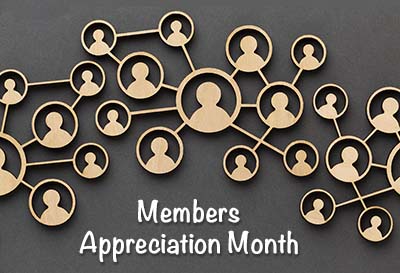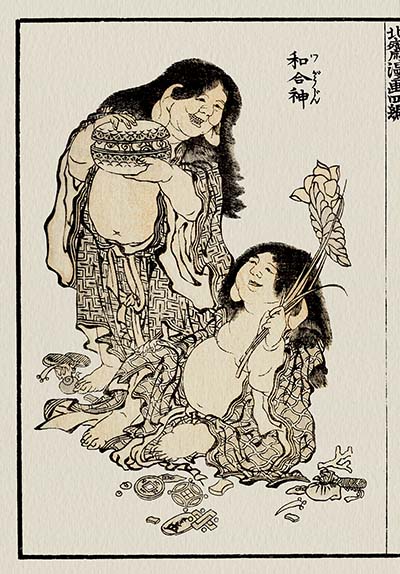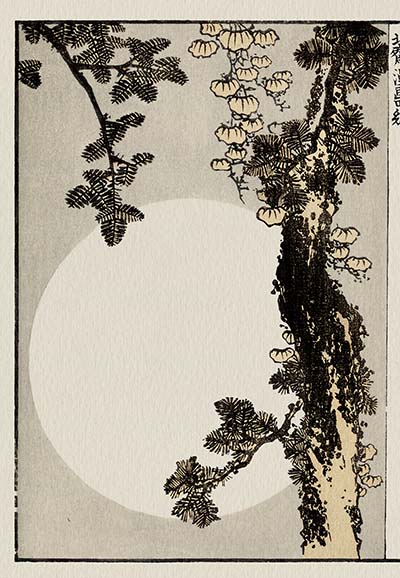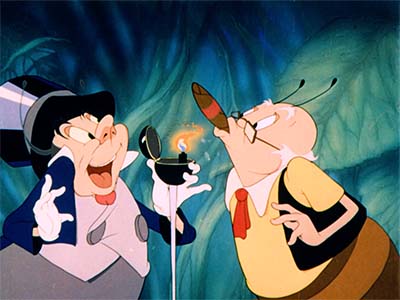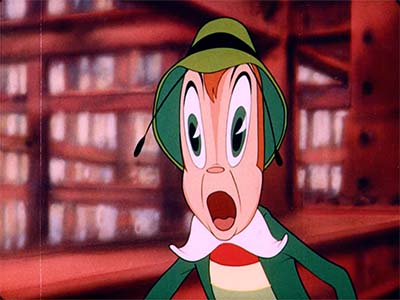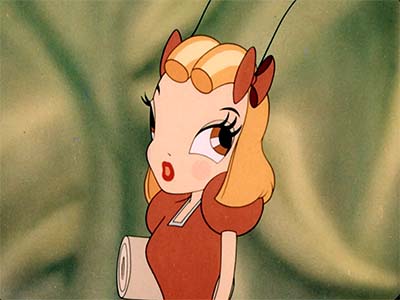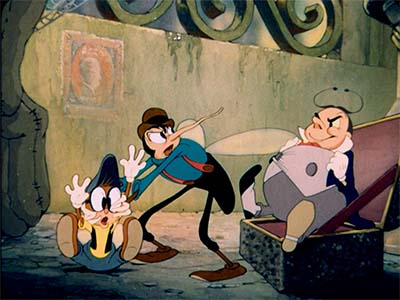
Every other month, Animation Resources shares a new Reference Pack with its members. They consist of e-books packed with high resolution scans video downloads of rare animated films set up for still frame study, as well as podcasts and documentaries— all designed to help you become a better artist. Make sure you download this Reference Pack before it’s updated. When it’s gone, it’s gone!
MEMBERS LOGIN To Download
JOIN TODAY To Access Members Only Content
The latest Animation Resources Reference Pack has been uploaded to the server. Here’s a quick overview of what you’ll find when you log in to the members only page…
PDF E-BOOK:
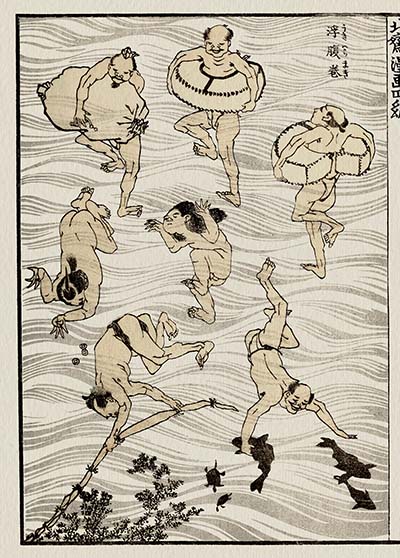
Hokusai Manga Volume 4

Katsushika Hokusai / 1814
Download this article
Katsushika Hokusai was arguably the greatest artist Japan ever produced. Best known for his monumental set of woodblock prints titled Thirty-Six Views of Mount Fuji, his career spanned more than 75 years, and in his lifetime he produced more than 30,000 paintings, sketches and woodblock prints. Hokusai’s fame attracted talented young artists, eager to study under him. He took on 50 pupils over the years. In 1812, he found himself in need of some quick money, and decided to publish an art manual called Quick Lessons In Simplified Drawing. The book was surprisingly successful, so the following year, he published the first volume of a series of sketchbooks known as Hokusai Manga. At that time, the word “manga” meant “random drawings” and that is exactly what his first volume consisted of… scenes of everyday life, animals, plants, landscapes, rendering experiments… the book contained very little text, just lots and lots of amazing drawings.
The volunteers of Animation Resources have taken great pains to insure that Hokusai’s genius is not undermined by poor reproduction. Hundreds of hours of careful digital restoration has gone into this e-book to create the ultimate version of Hokusai’s masterwork. You won’t find a copy of this book in this quality anywhere else.
SD VIDEO:
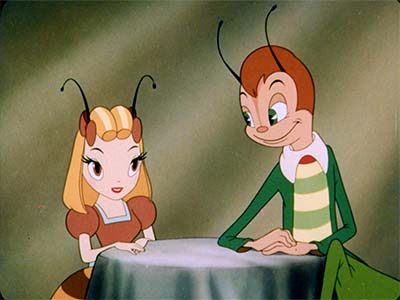
Hoppity Goes To Town

Dave Fleischer / Fleischer Studios / 1941
Dave Fleischer’s second animated feature Mr. Bug Goes To Town was a difficult production, some might say it was cursed. But despite its string of bad luck, the film stands as one of the crowning achievements of the Fleischer Studios, and is a model of what a non-Disney animated feature could be. Both Ralph Bakshi and Hayao Miyazaki have praised the film for the same reason. They consider it to be as Miyazaki put it, “the best example of a cartoon movie”.
In Disney films, the animators would go over each scene in passes, adding overlapping action- details reacting against the core motion, or add secondary action, where a character would be doing something else while performing. But in Mr. Bug the action occurs sequentially one at a time, not overlapping, with a focus on putting across the emotion or movement in the clearest and most expressive way possible… no lily-gilding or multi-layered polishing, just presenting the main point of the scene with maximum impact. We hope that the ability to step-frame through these scenes inspires you to focus on directness and focus in your own animation.
MEMBERS LOGIN To Download
JOIN TODAY To Access Members Only Content
SD VIDEO:
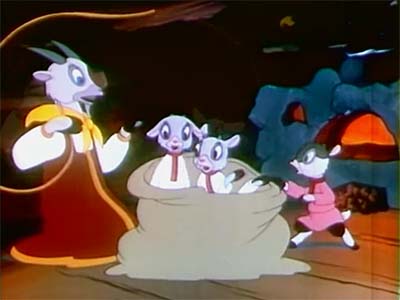
The Wolf & The Seven Kids

Pyotr Nosov / Souyzmultfilm / Russia / 1957
Download this article
“The Wolf And The Seven Kids” was based on a Russian fairy tale designed to teach children to be wary of strangers. The film has a great deal of dialogue, but it can be followed by a non-Russian speaker if you know the basic plot. I think you’ll be impressed at the high quality of the animation and backgrounds in this film. It’s amazing that films like this are virtually unknown in the United States.
SD VIDEO:

The Little Checkered Dog

Sophia Oldak / Studio Miniature Filmowych / Poland / 1968
Occasionally, I’m called upon to write about a film that I know very little about. This is one of those cases. This charming film was directed by Sophia Oldak for the Polish animation studio, Studio Miniature Filmowych in 1968. I have been told that this is the first of three films featuring the little checkered dog, but I can’t find the other two films.
The thing that appeals to me about this film is its simplicity. It doesn’t try to be fancy, with complicated animation, elaborate stop motion armatures, and richly detailed backgrounds. It tells a story on a child’s level simply, and with a great deal of appeal. It reminds me that making a film isn’t about working hard, it’s about putting across a character simply, with a maximum of personality.
MEMBERS LOGIN To Download
JOIN TODAY To Access Members Only Content
SD VIDEO:

Dog, Cat And… Ep 06

Leszek Komorowski / Studio Miniatur Filmowych, Poland / 1972
In this Reference Pack, we are sharing another short cartoon from a series produced by Studio Miniatur Filmowych, Pies, Kot I… which translates to Dog, Cat And… The episode is titled “Stove”. These cartoons are almost devoid of dialogue with the focus on loose, funny animation. In fact, the drawings are often hilarious on their own, even removed from their context within the gag sequence. The facial expressions are well observed, and the poses employ clear silhouettes that form funny graphic shapes.
Dog, Cat And… looks like it was a lot of fun to make. The film makers at Studio Miniatur Filmowych didn’t feel constrained by the ordinary lives of animals. Their characters can drive cars, build their own houses and go to exotic places. That freedom allowed the animators to keep their series fresh, and gave them the opportunity to experiment within a 10 minute format. Simple drawings, funny movement and no rules… these are the kinds of series that would work well as episodic internet cartoons.
SD VIDEO:
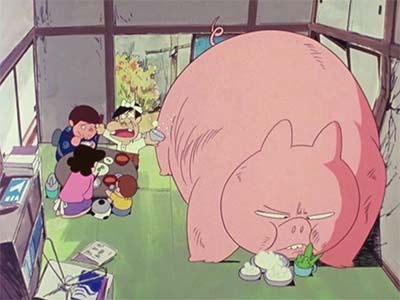
Ganso Tensai Bakabon Ep. 01 & 10

Hiroshi Saito / Tokyo Movie / Japan / 1975
Ganso Tensai Bakabon was the second series based on Fuji Akatsuka’s manga, debuting on October 6th, 1975. There were 103 half hour episodes produced by Tokyo Movie.
A lot of people believe the myth that there are 12 principles of animation. Nothing could be further from the truth. There are hundreds of principles, and animators with familiarity with all kinds of animated films know that. One of the principles that is used extensively in early TV anime is the use of exaggerated expressions. The technique involves creating impactful poses by exaggerating the facial expression to an absurd degree, while changing the proportions of the character to enhance the emotion being expressed. When a character expresses fear or surprise, their eyes can become huge and their head enlarges, their body becoming small with stubby legs and arms sticking straight out. A staggered pair of drawings often vibrates back and forth with a shocking sound effect. This series has plenty of great examples to analyze and break down to use in your own work.
MEMBERS LOGIN To Download
JOIN TODAY To Access Members Only Content
SD VIDEO:

Shock Of The New Ep. 03 & 04

Robert Hughes / BBC / 1980
Download this article
In the first 18 years of the 20th century, the world changed more than in the previous 18 centuries. The rise of the machine age that led to the horrors of the First World War was unprecedented. Rapid change has continued since then. Uncertainty and progress continue to go hand in hand into an unknown future.
In the early 1980s, I happened to see a series on PBS that blew my mind. It was titled “Shock Of The New” and it was hosted by Time Magazine’s art critic, Robert Hughes. It told the story of modern art in a different way, organizing the episodes by the meaning of the art, instead of following a strict chronology. The concepts were illustrated not only by images of art, but with footage illustrating the societal upheaval that inspired it. Hughes travelled about 250,000 miles to film the places and people in the series and spent over three years producing the films and companion book. It is one of the greatest pieces of art criticism that has ever been produced.
ANALYSIS:

Solo Performance Pt. 2

Curated By David Eisman
Download this article
This time, we return to the topic of solo performance. In Part Two, we will, as before, analyze four curated animation sequences and break them down frame-by-frame to best understand how the animation principles of solo performance and screen-presence can be applied in practice.
With these breakdown clips, we will learn about the concepts of solo performance and screen-presence- specifically how to generate and maintain screen-presence and support screen-presence with other elements, be they an additional character or a heap of dramatic effects. We’ll also learn how to use simplicity and purposeful staging to maintain screen-presence in a non-traditional, abstract solo performance. And lastly, we’ll learn how to use cheats to maintain clarity in character acting.
MEMBERS LOGIN To Download
JOIN TODAY To Access Members Only Content

As a special thank you to our annual General and Student members, we have created a special page where we will archive past Reference Packs. There will be a new rerun of a complete RefPack between the new ones.
ANNUAL MEMBER BONUS ARCHIVE

Available to Student and General Members
REFPACK031: December / January 2019-2020
PDF E-BOOK:
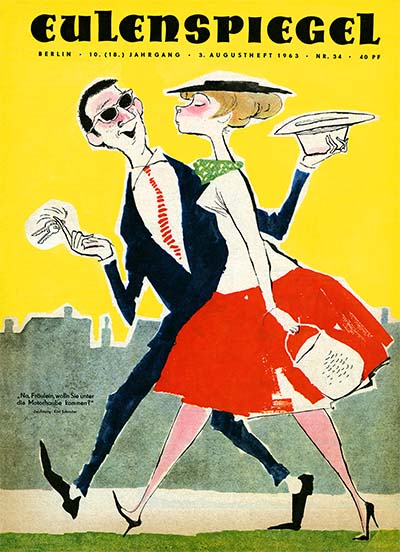
Eulenspiegel Volume One

July 1st to November 2nd, 1963
After the Second World War, satirical caricature magazines experienced a rapid decline. The general public in the post-war years wasn’t as receptive to radical politics and muckraking as they were before the war. One by one, satirical magazines around the world were replaced by illustrated current events magazines like Life, Look, The Illustrated London News and L’Illustration. However, behind the Iron Curtain, satirical magazines didn’t disappear after World War II, in fact, they flourished for a time. Chief among these magazines was Krokodil. It was launched a few years after the Russian Revolution. Political satire in the Soviet Union was a dangerous thing, but Krokodil was given a wide berth to lampoon the inefficiency and lack of initiative of mid level bureaucrats and the sloppiness of labor workers.
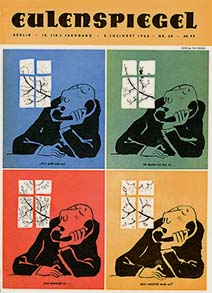
 Only three East German magazines survived after the Berlin Wall fell, and Eulenspiegel was one of them. It continues to be published to this day. Punch ceased publication in 1991 after more than a century and a half in print, Krokodil closed its doors in 2008, Mad Magazine recently announced that they were ending their print magazine. It may well be that Eulenspiegel is the last of the classic satirical humor magazines still in circulation. Animation Resources was fortunate to Find a batch of these rarely seen magazines in a bookshop in Hungary and had them shipped to us in the United States for digitization. We hope you find them useful.
Only three East German magazines survived after the Berlin Wall fell, and Eulenspiegel was one of them. It continues to be published to this day. Punch ceased publication in 1991 after more than a century and a half in print, Krokodil closed its doors in 2008, Mad Magazine recently announced that they were ending their print magazine. It may well be that Eulenspiegel is the last of the classic satirical humor magazines still in circulation. Animation Resources was fortunate to Find a batch of these rarely seen magazines in a bookshop in Hungary and had them shipped to us in the United States for digitization. We hope you find them useful.
Click to access the…
Annual Member Bonus Archive

Downloads expire after February 2025
DVD QUALITY VIDEO:

The Tale of the White Serpent
Toei / Taiji Yabushita & Kazuhiko Okabe / 1958
When Toei Animation undertook to create the first full color animated feature, they pushed their resources to their absolute limit. With a staff of nearly 1,400 people working on the film, and an extremely tight schedule of just eight months to complete it, they succeeded in making a wonderful film that is now considered the first Anime feature.
The copy of the film that we are are sharing with our members here is in Japanese with no subtitles, but dialogue is sparse and the story is easy to follow without words. In particular, pay attention to the excellent color and effects animation, as well as the use of humorous caricature in the crowd shots. There is a great deal to be learned from this film.
Click to access the…
Annual Member Bonus Archive

Downloads expire after February 2025
If you are currently on a quarterly membership plan, consider upgrading to an annual membership to get access to our bonus page with even more downloads. If you still have time on you quarterly membership when you upgrade to an annual membership, email us at…

membership@animationresources.org
…and we will credit your membership with the additional time. These bonus downloads expire after January 1st, 2025.
VIDEO PODCAST:

Christian Roman Interview

Animated Discussions 017 / Hosted by Davey Jarrell with Christian Roman
Download this article

 Christian Roman is a storyboard artist and director with over 30 years of experience in both TV and features. He storyboarded on 55 episodes of The Simpsons and on the Pixar classics Toy Story 3, Toy Story 4, Cars 3, Onward, and Elemental. He also directed on the TV series Fillmore, Mission Hill, and The Twisted Tales of Felix the Cat. He’s currently on the faculty at the School of Visual Arts. Listen to Christian talk about his creative process and the nuts and bolts of professional storyboarding in the latest episode of Animated Discussions!
Christian Roman is a storyboard artist and director with over 30 years of experience in both TV and features. He storyboarded on 55 episodes of The Simpsons and on the Pixar classics Toy Story 3, Toy Story 4, Cars 3, Onward, and Elemental. He also directed on the TV series Fillmore, Mission Hill, and The Twisted Tales of Felix the Cat. He’s currently on the faculty at the School of Visual Arts. Listen to Christian talk about his creative process and the nuts and bolts of professional storyboarding in the latest episode of Animated Discussions!
MEMBERS LOGIN To Download
JOIN TODAY To Access Members Only Content
Whew! That is an amazing collection of treasures! The most important information isn’t what you already know… It’s the information you should know about, but don’t know yet. We bring that to you every other month.
THIS IS JUST THE TIP OF THE ICEBERG!
Animation Resources has been sharing treasures from the Animation Archive with its members for over a decade. Every other month, our members get access to a downloadable Reference Pack, full of information, inspiration and animation. The RefPacks consist of e-books jam packed with high resolution scans of great art, still framable animated films from around the world, documentaries, podcasts, seminars and MORE! The best part is that all of this material has been selected and curated by our Board of professionals to aid you in your self study. Our goal is to help you be a greater artist. Why wouldn’t you want to be a member of a group like that?
Membership comes in three levels. General Members get access to a bi-monthly Reference Pack as well as a Bonus RefPack from past offerings in the in-between months. We offer a discounted Student Membership for full time students and educators. And if you want to try out being a member, there is a Quarterly Membership that runs for three months.
JOIN TODAY!
https://animationresources.org/membership/levels/
FREE SAMPLES!
Not Convinced Yet? Check out this SAMPLE REFERENCE PACK! It will give you a taste of what Animation Resources members get to download every other month! That’s 560 pages of great high resolution images and nearly an hour of rare animation available to everyone to download for FREE! https://animationresources.org/join-us-sample-reference-pack/


 Animation Resources depends on your contributions to support its projects. Even if you can’t afford to join our group right now, please click the button below to donate whatever you can afford using PayPal.
Animation Resources depends on your contributions to support its projects. Even if you can’t afford to join our group right now, please click the button below to donate whatever you can afford using PayPal.









 by
by 
![]()
![]() Animation Resources depends on your contributions to support its projects. Even if you can’t afford to join our group right now, please click the button below to donate whatever you can afford using PayPal.
Animation Resources depends on your contributions to support its projects. Even if you can’t afford to join our group right now, please click the button below to donate whatever you can afford using PayPal.













